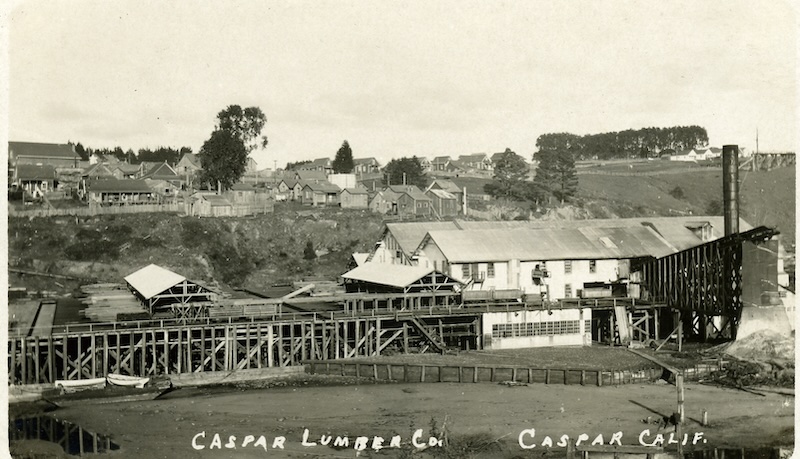When CalTrans rerouted Highway 1 in 1966 and completed the Caspar Creek Bridge, the new stretch of road ran through what had been the posh Caspar neighborhood of Nob Hill. It’s difficult to think of Caspar as having a notable hill, much less one with fancy houses and high property values, but back in the day it was where the men with the best-paying jobs lived with their families. The highway (such as it was) had gone right through town on what is now Caspar Road, but Nob Hill was higher up the coastal terrace and removed from the dust and noise down by the mill. Today, it’s possible to see the remaining Nob Hill houses directly west of the highway a short distance north of the bridge.

View of the Caspar mill looking to the northeast. The houses at the top of the hill in the center of the photo are on Nob Hill. Kelley House Museum photo.
The area got its name from the iconic one in San Francisco. That city’s California Hill was renamed in the 1870s when the Central Pacific Railroad’s Big Four (Huntington, Hopkins, Crocker, Stanford), known as “the Nobs,” built their mansions there. Nob is a shortening of the Anglo-Indian term Nabob, meaning a great ruler. The term came to be associated with people of conspicuous wealth or high status. The Caspar mill managers, foremen, millwrights, and bookkeepers may not have been nearly as wealthy as the Big Four, but they were the upper crust around here.
What we know about the residents of Nob Hill and their lives derives largely from news bits in the Mendocino Beacon during the first half of the last century. In September, 1908, the “Caspar Correspondences” column reported that Jacob Jackson and his bride had arrived and would be occupying the new house that was built for them on Nob Hill. Jackson was the grandson of J. G. Jackson, who acquired the Caspar Lumber Company in 1864.
In its heyday, Caspar had as many as 500 residents and the lumber company’s output was one of the largest on the coast. The company built a number of bungalows and cottages on the hill in the early teens, installed a new sewer there in 1915, and put in a sidewalk from its store in town the same year. That’s also when the company “rocked” the road leading up the hill so the “autoists” who lived there would have a smooth ride.
In April of 1916, the Women’s Study Club of Mendocino met with Mrs. W. H. Higgins at her Nob Hill home. She was the former Anna Burwash, daughter of Caspar pioneer Henry Burwash, and she was married to Walter Higgins, the manager of the Caspar Company Store (the white brick building at the south end of Caspar Road, which once had two stories under a gable roof). Mr. and Mrs. L. P. Hansen moved into their new home on Nob Hill in September, 1918. Lars Peter Hansen was the new millwright at the Caspar mill; he had been at the mill in Mendocino, where he built and lived in the house that is now Café Beaujolais.
In June, 1919, the Beacon reported breathlessly that a tennis court was being installed on Nob Hill. Superintendent Stickney [of the lumber company] was quoted as being sure that “all in the town would greatly enjoy it.” About ten years earlier, a tennis court had been created in Mendocino south of the Ford House, where “members of the town social set gathered on the clay-court most Saturday afternoons.”
Water was an issue in June, 1920, when the Beacon noted that “the company sank the wells on Nob Hill a little deeper to secure a better supply of water.” At that time, the well-known three-tank Caspar water tower was built to store the water and, a couple years later, a pipeline was laid from the tanks to Main Street “so as to furnish water for the downtown residents and the mill.” The tower was dismantled in 1984, but the pump house can still be seen on the east side of the highway about 100 yards north of the Caspar Creek Bridge.
Radio ownership by denizens of Nob Hill was deduced in 1923 when the Beacon observed “radio poles in back of the I. Kaufman residence on Nob Hill.” [In 1923, 1% of U.S. households owned a radio receiver; by 1937, 75% did.] Electricity had come to the communities on the coast in the early 1900s.
Throughout the late 20s and much of the 30s, the Beacon continued to report on important people moving into or out of houses on Nob Hill. Many worked for the lumber company, others owned stores in town, and a few held management positions with the WPA/CCC project that constructed the Mendocino Woodlands Recreation Area. However, the Depression reduced the demand for lumber and production decreased at the Caspar mill.
There were fewer mentions of Nob Hill in the newspaper, the last one being a report on the fire that burned down the house occupied by Ralph Freathy in April of 1949. His father had been Edward Freathy, the lumber company’s Woods Boss, and the house was owned by the lumber company. The mill closed in 1955 and the hill soon lost its lustre.
The Kelley House Museum is open from 11AM to 3PM Friday through Sunday. Drop in to see our current exhibit on the Northern Pomo. Walking Tours of Mendocino are available throughout the week; the cost is $25. Visit the Kelley House Event Calendar for a Walking Tour schedule.